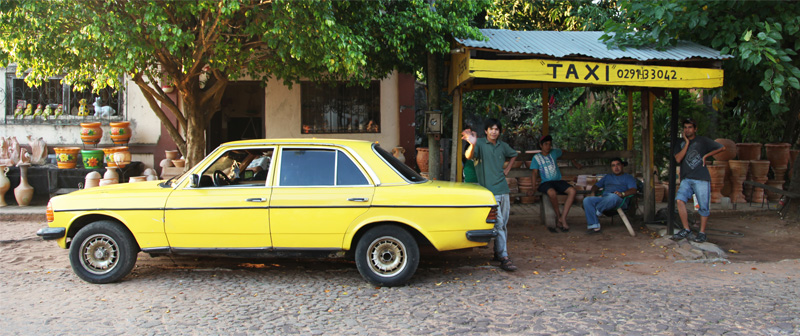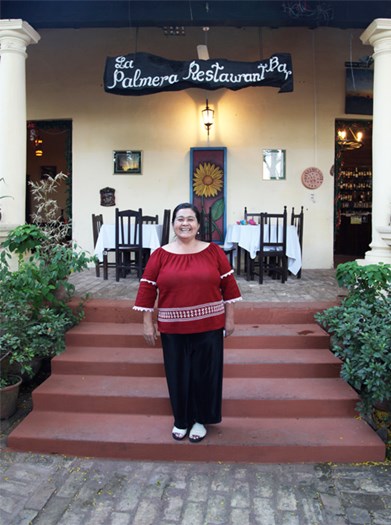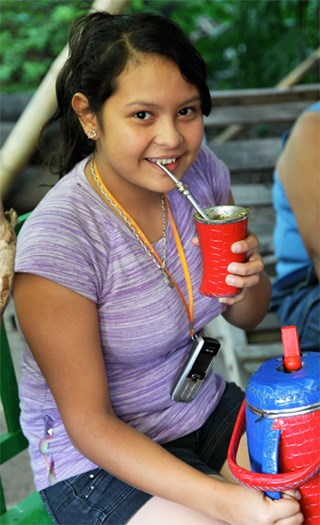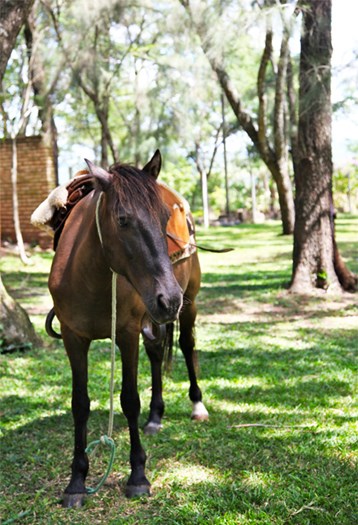ASUNCION, PARAGUAY - The words Fausto uses to greet us — “Mba’éichapa” — are unfamiliar, even to those in our small group who speak Spanish.
A sly smile creeps across his face as I scramble through my Spanish/English dictionary looking for a translation.
“Close the book,” the playful guide tells me, “because you won’t find mba’éichapa in there. I’m actually speaking Guarani, a local dialect we Paraguayans use.”
While Spanish is the official language of this tiny nation of six million people, Fausto says Guarani and Jopara, a hybrid of Spanish and Guarani, are also widely spoken.
“Welcome to the heart of South America,” Fausto says in Spanish and English as our bus pulls away from Asuncion airport and we begin our tour of this lovely land-locked country sandwiched between Argentina, Brazil and Bolivia.
Fausto talks passionately about his homeland, its diverse landscape, its people, its prairies and plains, and his country’s love of “futbol,” or soccer as we know it.

Above: Cabbies are great tour guides.
So, it comes as no surprise that one of our first stops in Asuncion is not at the city’s great cathedrals or regal buildings or statue-filled parks, but rather at the Futbol Sudamericano Conmenbol — the Museum of South American Football.
Fausto proudly tells us that the soccer museum is one of the most-visited tourist sites in Asuncion, whose colonial roots date back to the 1530s.
Fans from all over South America line up to have their pictures taken beside the giant soccer ball that sits at the museum’s entrance. Inside, foreign visitors cheer as they see displays of trophies and mementoes relating to their own soccer-crazy countries.
Multi-media displays throughout the museum bring to life great moments from the past. World Cup wins by Argentina and Brazil get the loudest cheers.
The soccer museum is a great introduction to Paraguay, a country that is a bit off the “normal” South American tourist route but one which is getting more popular thanks to its eco-tourism delights and friendly, welcoming people.
Like Ursula Irrazabal, the restaurant owner we meet in a small rural town who lunges at me when I enter her neatly kept property; wraps her strong meaty arms around my waist and hugs me like a long-lost relative.
The only thing better than Ursula’s heartfelt welcome is the food served at her La Palmera Restaurant and Bar.
“Try the chipa,” Ursula insists.
The delicious bread made of corn flour and cheese is one of the country’s favourite foods. We wash the chipa down with a local wine called cleric — Paraguay’s version of sangria — as the Spanish-speaking members of our group chat with Ursula.
Suddenly, some members of the group become emotional, with tears welling up in their eyes. I’m curious, so I ask Julio, a fellow traveller from El Salvador, to translate.



Left: Ursula the restaurant owner. Middle: Tereré drink is a Paraguayan favourite. Right: Paraguay is known for its beautiful landscape.
“Ursula says she lost her husband in an accident and was left with bills to pay and a restaurant to run,” whispers Julio. “She was determined to keep the business alive in his memory and borrowed money to make it work.
“She says that on days like today she is filled with pride as people from all over the world sit at her table. She wants everyone to feel at home in Paraguay and wants visitors like us to experience the love and hospitality that Paraguayans pride themselves in.”
Back on the bus, Javier, a local guide who is showing us Paraguay’s lovely mountainous interior, offers us a coffee drink called tereré .
“You must try two types of drinks while in Paraguay — tereré and mate,” says Javier.
Mate is made with a combination of dried, ground herbs and is drunk through a filtered straw known as a bombilla or bomba. It’s very sociable to share drinks in Paraguay, hence the filtered straw.
At stops in rural towns en route to the ecological reserve at Mbatoví, we’re introduced to the handicrafts for which Paraguay is famous, such as brightly decorated and delicate hand-painted pottery.
Eco Reserva Mbatoví is the largest ecological adventure park in Paraguay. Some members of our group compare it to Costa Rice — lots of waterfalls; a lush tropical setting; zip line adventures, rock climbing, and hikes across suspension bridges that swing precariously over a carpeted forest floor.
A stop at the holiday town of La Quinta, where affluent Paraguayans come to relax and swim or go horseback riding on weekends, gives us the chance to sample more delicious cuisine and hospitality. This small outpost, about 80 kilometres from Asuncion, is a tropical paradise where dishes are infused with locally grown fruits and vegetables and where the pace of life slows to a crawl.
From the comfort of my poolside hammock, I look out over La Quinta’s diverse landscape and watch the sun turn shades of red, orange and purple before disappearing behind some far-off hills.
Paraguay, I’m beginning to understand, is known as the “Heart of South America” not because of its geographical location but rather because of how lovingly it treats visitors.
Information
• Canadians need a visa to enter Paraguay.
• The local currency is known as the guarani but the U.S. dollar is also widely accepted.
• Copa Airlines offers four-times weekly service from Toronto to Paraguay via Panama. For information and schedules, go to www.copaair.com.
Cheesy Chipa bread is one of Paraguay’s most famous dishes.
About the Author
Driven by a passion for travel and adventure, she expresses her creativity through stories and photos. Jessica's work has appeared extensively in national newspapers and magazines and she is a regular contributor to TraveLife magazine. Her portfolio encompasses a diverse cross-section of topics, ranging from design, lifestyle, food, and travel to business and investing. She holds a Bachelor of Arts, Honours Degree from Queen's University in Communication Culture and Information Technology. She has also earned college certificates in the fields of Commercial Photography and Public Relations. Jessica has travelled to and written about destinations in Africa, Asia, South America, Europe, the United States, Canada and the Caribbean.